RPG Review: Guildmaster’s Guide to Ravnica
Ravnica is a plane-spanning city, stretching far beyond imagination. From the heights of the Aeire of the Firemind to Duskmantle in the Undercity, the wonders of the city are innumerable. In the newest supplement from Wizards of the Coast, Dungeons & Dragons finally visits a plane of Magic: The Gathering.
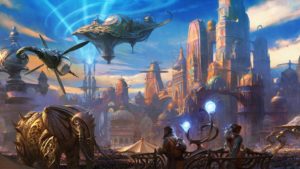
Ravnica has been a long time coming. For a couple of years, Wizards has been publishing PDF supplements called Planeshift, providing content for players to run games of D&D within the worlds of Magic the Gathering. Of particular note, I really enjoy Innistrad, a horror setting you could easily run Curse of Strahd in, or Ixalan, where I had previously suggested you set Tomb of Annihilation. This is the first time, however, we’re getting an official D&D setting book in MTG’s 25-year history.
Ravnica is a setting different than many others, in that it’s a bit of a fantasy Coruscant. The city extends across the entire plane. Note here that the plane isn’t a planet. It’s unclear how far the city extends. The book focuses on the Tenth District, a hub of all Guild activity.
The Guilds are the primary focus of the book. There are Ten Guilds, all tied together through a thing known as the Guildpact, keeping them at peace. Each runs a particular sector of society, from government and military to scientific research and crime. Each person in Ravnica chooses the Guild they will align themselves with based on their beliefs and goals in life. The book does a very good job of explaining these guilds, providing character backgrounds for each, and helping players determine what guild they will choose based on their class, race, and personality.
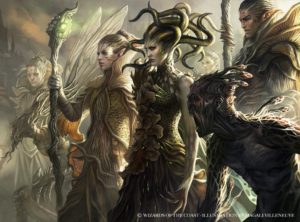
The game establishes the races available in Ravnica, some of which are in the PHB, such as Elf and Human, while others are new, such as Centaurs, Goblins, Loxodons (giant elephant men), Minotaurs, Simic Hybrids (scientific experiments merging races together), and Vedalken (blue-skinned humans who are partially amphibious). There are also new subclasses, and guides explaining what subclasses work best for particular guilds.
The game also has really great mechanics for rank and renown that would work in any D&D setting, giving benefits to characters who rise in the ranks of their particular guilds. This section is really substantial, establishing who these guilds are, what they do, and how they should be played.
As I said before, the book focuses on the Tenth District, which has six precincts within it, each with a different role and flavor. You get a close-up view of these precincts, while also keeping them open for you to add a lot of your own material. This section is also really useful if you aren’t playing in Ravnica, because it provides tables for random people you may find and different events and rumors. It’s a great resource for designing your own neighborhoods in cities. There being six precincts, you could definitely set up a session by having the players roll a d6 to determine what precinct they’ll be in that session, then rolling on the rumor table there to generate the adventure. rThe simple maps within are really gorgeous as well, though not necessarily useful for the tabletop, as they mostly just look like piles of buildings.
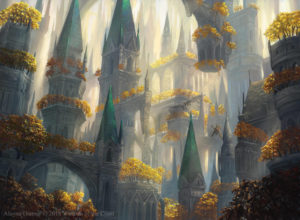
The chapter on creating adventures is a must-have, at least for me. While the book does a good job explaining the world, this chapter provides plot hooks to really help you delve into Ravnica. There are lots of random tables to roll or select from, then a section on each guild with some plot hooks, as well as fantastic maps by Dyson Logos for generic but distinct locations, such as a Boros Legion Garrison. You could easily get a lot of mileage off this chapter alone.
Krenko’s Way is a short 1st level adventure which introduces characters to the world and multiple guilds. The heroes are hunting for a notorious goblin crimeboss, Krenko, to bring him to justice. The guilds are seeking him out or helping him as well. There’s a great table giving the timeline for the story, with Krenko gathering his forces. I’ve always liked timelines, because it puts players on edge, and giving plot hooks for the players to disrupt. It’s a nice little adventure that reminds me of some of my early games of Star Wars, running through the streets of Coruscant.
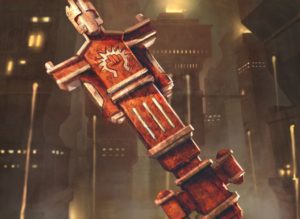
The magic item chapter is short, but provides some interesting new items, some taken directly from cards in Magic, such as the Guild Keyrunes, foot-long keylike items that transform into creatures such as Giant Eagles of Dire Wolves. I also liked the Spies’ Murmur, which is basically a bluetooth headset. I wouldn’t incorporate it into a setting without such universal magic as this one, but it makes for easier communication between PCs. The Rakdos Riteknife actually has a save-or-die effect, so it should scare the bujeezus out of any players who have to fight against it, and become an incredible artifact if they can acquire it.. The other items are interesting, but I would have liked to see this chapter fleshed out some more and dynamic items.
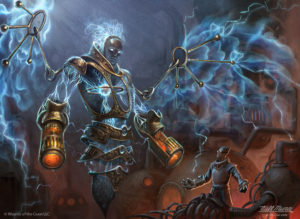
The final chapter is the mini-Monster Manual. This section has a ton of creatures within, including the stats for the leaders of each Guild, such as Aurelia, a powerful Angel who leads the forces of Boros into battle, Rakdos, an immense demon who revels in the sadistic entertainment of his cult, or Niv Mizzet, a massive (and CR 26) dragon who manages the Izzet’s insane experiments. Each guild master is fantastic and interesting, and would make a great NPC for your own campaign regardless of if you were playing in Ravnica or not. Simply change the name, and you’re good to go.
I really love this book. I started playing Magic a little before the first Ravnica block released, so I’ve known about this diverse and interesting world for a while now. I particularly love the Izzet’s mad experiments in electricity and fire, and Orzov’s ghost banks. The artwork of the book looks to mostly be taken directly from MTG cards, which I’m fine with, because the art is too beautiful to be shoved onto a tiny card of only an inch or so on a side. Hopefully, this review has also shown you how you can incorporate the book into your campaign outside of Ravnica as well if you aren’t using the setting. This would work particularly well in melding this into Waterdeep: Dragon Heist to create a more dynamic and lived-in city.
If you have any interest in a new setting beyond anything we’ve seen in D&D before, or are looking for somewhere new to throw a party into, you should definitely check out this book.
Wizards of the Coast sent a copy of Guildmaster’s Guide to Ravnica to Dice Monkey for review.

